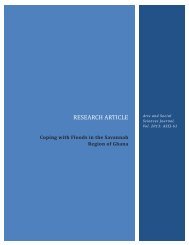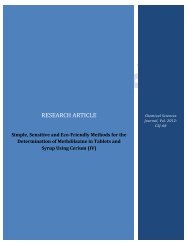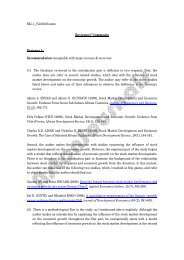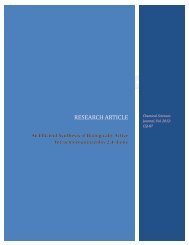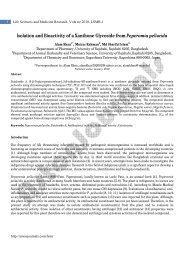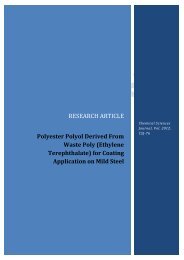Synthesis of Some New Quinazoline Derivatives ... - AstonJournals
Synthesis of Some New Quinazoline Derivatives ... - AstonJournals
Synthesis of Some New Quinazoline Derivatives ... - AstonJournals
Create successful ePaper yourself
Turn your PDF publications into a flip-book with our unique Google optimized e-Paper software.
Chemical Sciences Journal, Volume 2011: CSJ-181<strong>Synthesis</strong> <strong>of</strong> <strong>Some</strong> <strong>New</strong> <strong>Quinazoline</strong> <strong>Derivatives</strong> and Theoretical Studies <strong>of</strong>their GeometriesR Kaur, M Bansal, B Kaur*Department <strong>of</strong> Chemistry, Punjabi University, Patiala-147002, Punjab, India.*Correspondence to: Balbir Kaur, aries_balbir@yahoo.co.inAbstractAccepted: January 18, 2011; Published: April 30, 2011<strong>Quinazoline</strong> and their fused-ring systems are well known for their potential biological activity. Inspired by this and in view <strong>of</strong> the usefulness <strong>of</strong>heterocyclic thiols as vulcanization accelerators, new derivatives viz. <strong>Quinazoline</strong>-2-thiols were prepared. These were synthesized by thecondensation <strong>of</strong> 2-[isothiocyanato(substituted phenyl)methyl]-3,4-dihydronaphthalene-1(2H)-one with primary aromatic amines. All theprepared compounds have been characterized by elemental analysis, IR and mass spectroscopy.Keywords: <strong>Quinazoline</strong>; <strong>Quinazoline</strong>-2-thiols; Fused-ring systems; Condensation.1. IntroductionIn the family <strong>of</strong> heterocyclic compounds, nitrogen-containing heterocycles are an important class <strong>of</strong> compounds in medicinalchemistry. There has been considerable interest in the development <strong>of</strong> preparative methods for the production <strong>of</strong> quinazolines[1]. This is because quinazolines and their ring-fused derivatives display a broad spectrum <strong>of</strong> biological activities [2] like antitubercular,analgesic, anti-inflammatory, and anti-bacterial. Adding to this class <strong>of</strong> heterocyclic compounds, we have reportedearlier [3] the reaction <strong>of</strong> aromatic aldehyde, thiourea and cyclic ketone to synthesize quinazoline-2(1H)-thiones. Then, thesewere alkylated/aralkylated. The present paper describes the reaction <strong>of</strong> 2-[isothiocyanato(substituted phenyl)methyl]-3,4-dihydronaphthalene-1(2H)ones with primary aromatic amines to give another cyclized products viz. quinazoline-2-thiols. Ourliterature survey reveals that quinazoline-2-thiols are unknown in the literature except for a report mentioning the synthesis <strong>of</strong>similar compounds [4, 5] 1-(substituted phenyl)-4,4,6-trimethyl-1H,4H-pyrimidine-2-thiols. The later compounds have shownmany biological activities [6-8] like anticonvulsive activity like a well-known drug phenobarbitone, as the structure <strong>of</strong> both <strong>of</strong>these, are somewhat chemically similar. Also, it has been mentioned in the literature that heterocyclic thiols can act asvulcanization accelerators [4]. Therefore, working on the similar guidelines and in continuation with our research programdealing with the synthesis <strong>of</strong> biologically active compounds, we report herein a general route to the title compounds.2. MethodsMelting points were determined in open-end capillaries and are uncorrected. Compounds were checked for their purity by TLCon silica gel G plates and spots were located by iodine vapors. 1 H NMR spectra were recorded on BRUKER ADVANCE II 400 NMRSpectrometer using TMS as internal standard. The mass spectra were obtained on a JEOL 5x102/DA-6000 mass spectrometer.The IR spectra were recorded on Perkin-Elmer spectrum RX IFT-IR System using KBr pellets. Elemental analyses <strong>of</strong> the newlysynthesized compounds were carried out on Perkin Elmer model 2400 C H N analyzer. All the compounds gave satisfactoryelemental analysis within ±0.4% <strong>of</strong> theoretical values. The microwave-irradiated reactions were performed in domestichousehold microwave oven Samsung M177N.General procedure for the synthesis <strong>of</strong> 2-arylidenetetralin-1-one (1a-1i):A mixture <strong>of</strong> -tetralone and substituted aromatic aldehydes were subjected to microwave heating for 2-5 minutes usingabsolute alcohol (5 ml) as energy transfer medium and conc. HCl (0.5 ml) as a catalyst. The reaction mixture was cooled to roomtemperature. The solid, so obtained, was filtered, washed with ethanol and finally crystallized from ethanol to give 1a-1i.http://astonjournals.com/csj
2 Research ArticleTable 1: <strong>Synthesis</strong> <strong>of</strong> 2-arylidenetetralin-1-one (1a-1i).Product R Time Yield M.pt.( 0 C) Lit.m.pt 14-16 ( 0 C) IR (KBr, cm -1 )(min) (%)1a H 4.30 50 104-105 105,102-103 1661.2 (C=O),1589.6(C=C), 1491.1( C --- C )1b 2,4(Cl) 2.30 35 54-56 ---- ----1c 4-NO 2 4.00 42 182-183 184,185 ----1d 3-NO 2 4.00 38 142-143 ---- ----1e 4-OCH 3 4.15 40 109-110 110,109 ----1f 2,3(O-CH 2 - 4.30 75 133-139 ---- ----O)1g 4-Br 4.00 47 158-159 ---- -----1h 3-OH 4.00 37 135-139 ---- -----1i 4-CH 3 3.30 36 125-126 124 -----The PMR spectra <strong>of</strong> compound 1e shows a multiplet due to aromatic protons at 7.89-6.93. The triplets at 3.09-3.07 & 2.94-2.93 were assigned to C 5 CH 2 & C 6 CH 2 . A singlet was observed at 3.83 due to 4-OCH 3 . Also, a singlet was observed at 1.79 dueto =CH proton.General procedure for the synthesis <strong>of</strong> 2-[isothiocyanato(substituted phenyl)methyl]-3,4-dihydronaphthalene-1(2H)-one (2a-2i):The mixture <strong>of</strong> compound 1a-1i (1 mole) and potassium isothiocyanate (1 mole) was taken in a conical flask. To it few pieces <strong>of</strong>ice were added and then H 2 SO 4 (9.8 ml, 1 mole) was added drop wise. It was stirred for 15-20 minutes. The solid product, soobtained, was washed with sodium carbonate and then with distilled water. The IR spectral values <strong>of</strong> some <strong>of</strong> the representativemembers are given below:Table 2: <strong>Synthesis</strong> <strong>of</strong> 2-[isothiocyanato(substituted phenyl)methyl]-3,4-dihydronaphthalene-1(2H)-one (2a-2i).Product R IR (KBr, cm -1 ); PMR (ppm, )2a H 2056.1 (NCS); 1664.8 (C=O); 1454.7( C --- C ); 1223.7 (C-N)2d 3-NO 2 2050.3 (NCS); 1664.2 (C=O), 1529.3 (NO 2 ); 1224.4 (C-N)2e 4-2055.8 (NCS); 1645 (C=O); 1510 ( C --- C ); 1178.4 (C-N):OCH 3 7.99-6.97 (m, 8H, Ar-H), 3.85 (s, 3H,4- OCH 3 ), 3.09-3.07 (t, 2H, C 5 CH 2 or C 6 CH 2 ), 2.94-2.93 (t, 2H, C 5 CH 2 orC 6 CH 2 ), 1.81-1.80 (d, 1H, C 2 H), 1.42-1.35 (d, 1H, C 1 H)2i 4-CH 3 2057.9 (NCS); 1654.1 (C=O); 1516.4 ( C --- C ); 1313 (C-N)<strong>Synthesis</strong> <strong>of</strong> 1-(substitutedphenyl)-4-aryl-1,4,5,6-terahydrobenzo[h]quinazoline-2-thiol (3-9):A mixture <strong>of</strong> 2a-2i (0.01 mole), substituted anilines (0.01 mole) and ethanol (2-3 ml) was taken in a flask. To it, few drops (4-5) <strong>of</strong>H 2 SO 4 was added and stirred for 5-10 minutes. Solid separated was washed with glacial acetic acid and then with distilled water.Characterization data <strong>of</strong> 1-(substitutedphenyl)-4-aryl-1,4,5,6-terahydrobenzo[h]quinazoline-2-thiol (3-9):Product Z R Yield; IR (KBr, cm -1 ); Mass(m/z); Elemental analysis, 1 H (, ppm)3a 2-CH 3 H 76%; 217-219; 2850.4 (arom. C-H str.), 2604.7 (S-H), 1637 (C=N), 1560(C=C), 1498.4( C --- C ); 1313.9 (C-N)382.10 M + (60.79%), 218.15 (97.04%), 128.05 (3.07%), 105.90 (100%),90.15 (4.36%), 77 (28.65%), 65.05 (6.61%), 50.05 (5.55%)Anal. Calcd. For C 25 H 22 N 2 S: C78.53; H 5.76; N 7.33. Found: C 78.45; H5.62; N 7.21%3b 2-CH 3 2,4(Cl) 40%; 215-217; Anal. Calcd. For C 25 H 20 N 2 S: C66.66; H 4.44; N 6.22. Found:C 66.56; H 4.38; N 6.15%3c 2-CH 3 4-NO 2 77%; 223-225; Anal. Calcd. For C 25 H 21 N 3 SO 2 : C70.26; H 4.92; N 9.84.http://astonjournals.com/csj
Chemical Sciences Journal, Volume 2011: CSJ-183Found: C 70.19; H 4.88; N 9.76%3d 2-CH 3 3-NO 2 44%; 218-220; 2909.4 (arom. C-H str.), 2654.6 (S-H), 1616.9 (C=N),1544.5 (C=C), 1495.2( C --- C ); 1394.4 (C-N)Anal. Calcd. For C 25 H 21 N 3 SO 2 : C70.26; H 4.92; N 9.84. Found: C 70.22; H4.86; N 9.80%3e 2-CH 3 4-OCH 3 13%; 222-224; 2870.2 (arom. C-H str.), 2604.6 (S-H), 1640.4 (C=N), 1590(C=C), 1461.9 ( C --- C ); 1302 (C-N)7.95 (s, 1H, SH), 7.66-6.78 (m, 12H, Ar-H), 4.80 (s, 1H, C 4 H), 3.74 (s, 3H, 4-OCH 3 ), 3.09-3.07 (t, 2H,C 5 CH 2 or C 6 CH 2 ), 2.94-2.93 (t, 2H, C 5 CH 2 orC 6 CH 2 ), 2.54-2.53 (s, 3H, 4-OCH 3 ), 2.21 (s, 3H, CH 3 )Anal. Calcd. For C 26 H 24 N 2 SO: C75.72; H 5.82; N 6.79. Found: C 75.65; H5.78; N 6.65%3f 2-CH 3 2,3(O-CH 2 -O)85%; 215-219; 276 (1.75%), 122 (4.58%), 65 (5.88%), 63.95 (100%),58.10 (0.60%), 52.10 (6.85%), 40.10 (2.54%) Anal. Calcd. ForC 26 H 22 N 2 SO 2 : C73.24; H 5.16; N 6.57. Found: C 73.16; H 5.20; N 6.42%3g 2-CH 3 4-Br 224-225; 2820 (arom. C-H str.), 2589 (S-H), 1601.9 (C=N), 1485.2 (C=N),1400.2( C --- C ); 1317.5 (C-N)Anal. Calcd. For C 25 H 21 N 2 S: C 64.93; H 4.54; N 6.06. Found: C 64.99; H4.42; N 6.01%3h 2-CH 3 3-OH 38%; 228-230; Anal. Calcd. For C 25 H 22 N 2 SO: C 75.38; H 5.53; N 7.03.Found: C 75.29; H 5.47; N 6.95%3i 2-CH 3 4-CH 3 38%; 222-224; 2910.4 (arom. C-H str.), 2655.3 (S-H), 1586.8 (C=N),1544.8 (C=C), 1495( C --- C ); 1316.4 (C-N)Anal. Calcd. For C 26 H 24 N 2 S: C 78.78; H 6.06; N 7.07. Found: C 78.69; H5.99; N 7.01%4a 4-CH 3 H 69%; 239-241; Anal. Calcd. For C 25 H 22 N 2 S: C78.53; H 5.76; N 7.33. Found:C 78.49; H 5.66; N 7.25%4b 4-CH 3 2,4(Cl) 38%; 232-234; Anal. Calcd. For C 25 H 20 N 2 S: C66.66; H 4.44; N 6.22. Found:C 66.59; H 4.37; N 6.17%4c 4-CH 3 4-NO 2 69%; 216-218; Anal. Calcd. For C 25 H 21 N 3 SO 2 : C 70.26; H 4.92; N 9.84.Found: C 70.21; H 4.86; N 9.78 %4d 4-CH 3 3-NO 2 36%; 237-239; Anal. Calcd. For C 25 H 21 N 3 SO 2 : C70.26; H 4.92; N 9.84.Found: C 70.20; H 4.95; N 9.78%4e 4-CH 3 4-OCH 3 07%; 220-222; Anal. Calcd. For C 26 H 24 N 2 SO: C 75.72; H 5.82; N 6.79.Found: C 75.68; H 5.75; N 6.83%4f 4-CH 3 2,3(O-CH 2 -O)77%; 221-223; Anal. Calcd. For C 26 H 22 N 2 SO 2 : C73.24; H 5.16; N 6.57.Found: C 73.29; H 5.11; N 6.49%4g 4-CH 3 4-Br 31%; 246-248; 2874.8 (arom. C-H str.), 2596.4 (S-H), 1592.2 (C=N),1485.5 (C=C), 1400.1( C --- C ); 1297.9 (C-N)Anal. Calcd. For C 25 H 21 N 2 S: C 64.93; H 4.54; N 6.06. Found: C 64.89; H4.46; N 5.97%4h 4-CH 3 3-OH 38%; 253-255; Anal. Calcd. For C 25 H 22 N 2 SO: C 75.38; H 5.53; N 7.03.Found: C 75.43; H 5.48; N 6.99%4i 4-CH 3 4-CH 3 38%; 235-237; 2924 and 2849 (arom. (C-H), 2590.9 (S-H), 1617.8 (C=N),1559.8 (C=C), 1458.2( C --- C ); 1320.9 (C-N)396, 277, 276, 128, 105, 103, 65, 58, 40Anal. Calcd. For C 26 H 24 N 2 S: C 78.78; H 6.06; N 7.07. Found: C 78.71; H6.12; N 7.13%5a 4-OCH 3 H 71%; 246-249; 2918 (arom. C-H str.), 2603.4 (S-H), 1618.1 (C=N), 1513.5(C=C), 1458.1( C --- C ); 1303 (C-N)Anal. Calcd. For C 25 H 22 N 2 SO: C 75.37; H 5.53; N 7.03. Found: C 75.29; H5.44; N 7.11%5b 4-OCH 3 2,4(Cl) 77%; 240-242; Anal. Calcd. For C 25 H 20 N 2 SO: C 64.38; H 4.29; N 6.01.Found: C 64.29; H 4.21; N 5.92 %5c 4-OCH 3 4-NO 2 90%; 241-243; Anal. Calcd. For C 25 H 21 N 3 SO 2 : C 67.72; H 4.74; N 9.48.Found: C 67.68; H 4.63; N 9.40 %5d 4-OCH 3 3-NO 2 34%; 238-240; Anal. Calcd. For C 25 H 21 N 3 SO 2 : C 67.72; H 4.74; N 9.48.Found: C 67.66; H 4.67; N 9.42 %http://astonjournals.com/csj
4 Research Article5e 4-OCH 3 4-OCH 3 65%; 253-255; Anal. Calcd. For C 26 H 24 N 2 SO 2 : C 72.89; H 5.61; N 6.54.Found: C 72.76; H 5.57; N 6.49 %5f 4-OCH 3 2,3(O-CH 2 -O)78%; 247-249; Anal. Calcd. For C 26 H 22 N 2 SO 3 : C 70.59; H 4.98; N 6.33.Found: C 70.48; H 4.89; N 6.39 %5g 4-OCH 3 4-Br 254-255; Anal. Calcd. For C 25 H 21 N 2 SO: C 62.76; H 4.39; N 5.86. Found: C62.69; H 4.30; N 5.74 %5h 4-OCH 3 3-OH 269-271; Anal. Calcd. For C 25 H 22 N 2 SO 2 : C 72.46; H 5.31; N 6.76. Found: C72.52; H 5.39; N 6.82 %5i 4-OCH 3 4-CH 3 74%; 245-247; 2919.6 (arom. C-H str.), 2596.4 (S-H), 1600 (C=N), 1586.6(C=C), 1453.6( C --- C ); 1317.6 (C-N)Anal. Calcd. For C 26 H 24 N 2 SO: C 75.73; H 5.82; N 6.79. Found: C 75.68; H5.77; N 6.69 %6a 4-Cl H 71%; 242-244; Anal. Calcd. For C 24 H 19 N 2 S: C 71.64; H 4.73; N 6.96. Found:C 71.52; H 4.79; N 6.88 %6b 4-Cl 2,4(Cl) 58%; 254-256; Anal. Calcd. For C 24 H 17 N 2 S: C 61.28; H 3.62; N 5.95. Found:C 61.23; H 3.68; N 5.89 %6c 4-Cl 4-NO 2 33%; 229-231; Anal. Calcd. For C 24 H 18 N 3 SO 2 : C 64.43; H 4.03; N 9.39.Found: C 64.47; H 4.09; N 9.25 %6d 4-Cl 3-NO 2 37%; 244-246; Anal. Calcd. For C 24 H 18 N 3 SO 2 : C 64.43; H 4.03; N 9.39.Found: C 64.39; H 4.11; N 9.29 %6e 4-Cl 4-OCH 3 10%; 235-237; Anal. Calcd. For C 25 H 21 N 2 SO: C 69.44; H 4.86; N 6.48.Found: C 69.47; H 4.78; N 6.32%6f 4-Cl 2,3(O-CH 2 -O)79%; 240-242; Anal. Calcd. For C 25 H 19 N 2 SO 2 : C 67.26; H 4.26; N 6.28.Found: C 67.19; H 4.23; N 6.24 %6g 4-Cl 4-Br 31%; 253-255; Anal. Calcd. For C 24 H 18 N 2 S: C 59.75; H 3.73; N 5.81. Found:C 59.67; H 3.65; N 5.72 %6h 4-Cl 3-OH 37%; 264-266; Anal. Calcd. For C 24 H 19 N 2 SO: C 68.89; H 4.54; N 6.69.Found: C 68.80; H 4.42; N 6.58 %6i 4-Cl 4-CH 3 74%; 255-256; 2925.9 (arom. C-H str.), 2590 (S-H), 1617.2 (C=N), 1559.8(C=C), 1494.2( C --- C ); 1289.2 (C-N)357, 229,129, 128, 127, 125, 92, 65, 26Anal. Calcd. For C 25 H 21 N 2 S: C 72.11; H 5.05; N 6.73. Found: C 72.02; H5.12; N 6.65 %7a 4-COOH H 71%; 2911.7 (arom. C-H), 2596 (S-H), 1613.8 (C=N), 1513.8 (C=C), 1431.7(C --- C ); 1394.5 (C-N)Anal. Calcd. For C 25 H 20 N 2 SO 2 : C 72.81; H 4.85; N 6.79. Found: C 72.72; H4.93; N 6.68 %7i 4-COOH 4-CH 3 46%; 2919.5 (arom. C-H), 2603.9 (S-H), 1601.2 (C=N), 1586.6 (C=C),7f 4-COOH 2,3(O-CH 2 -O)1455.3 ( C --- C ); 1317.7 (C-N)Anal. Calcd. For C 26 H 22 N 2 S: C 73.23; H 5.16; N 6.57. Found: C 73.15; H5.12; N 6.65 %71%; 230-232(d); 91 (2.01%), 65.05 (1.88%), 52.40 (1.50%), 43.90(100%)Anal. Calcd. For C 26 H 20 N 2 SO 4 : C 68.42; H 4.38; N 6.14. Found: C 68.32; H4.29; N 6.09 %8a H H 2874.1 (arom. C-H), 2588.9 (S-H), 1600 (C=N), 1557.8 (C=C), 1494.3(C --- C ); 1328.7 (C-N)Anal. Calcd. For C 24 H 20 N 2 S: C 78.26; H 5.55; N 7.61. Found: C 78.35; H5.48; N 7.72 %8e H 4-OCH 3 2871.6 (arom. C-H), 2589 (S-H), 1600.1 (C=N), 1494.6 (C=C), 1328.7 (C-N)Anal. Calcd. For C 25 H 22 N 2 S: C 75.37; H 5.53; N 7.03. Found: C 75.28; H5.43; N 7.24 %8i H 4-CH 3 2590 (S-H), 1654.1 (C=N), 1508.3 (C=C)Anal. Calcd. For C 25 H 22 N 2 S: C 78.53; H 5.76; N 7.33. Found: C 78.46; H5.82; N 7.21 %9i 2-NH 2 4-CH 3 3334 & 3412 (N-H), 2924 (arom. C-H), 2596.4 (S-H), 1577 (C=N), 1540.9(C=C), 1463.8 (C --- C ); 1316.7 (C-N)269, 176, 128, 127, 106, 92, 65, 59, 41Anal. Calcd. For C 25 H 23 N 3 S: C 75.56; H 5.79; N 10.57. Found: C 75.67; H5.70; N 10.46 %http://astonjournals.com/csj
Chemical Sciences Journal, Volume 2011: CSJ-1853. Results and Discussion2-Arylidenetetraline-1-one (1), obtained by the reaction <strong>of</strong> -tetralone and substituted aromatic aldehyde, when treated withpotassium isothiocyanate gave 2-[isothiocyanato(substituted phenyl)methyl]-3,4-dihydronaphthalene-1(2H)-one (2). Infraredabsorption spectra measurements <strong>of</strong> compounds 2a-2i showed a band at about 2040 cm -1 , the characteristic broad bandattributed to the isothiocyano group. This compound on further reaction with primary aromatic amine gave 1-(substitutedphenyl)-4-aryl-1,4,5,6-terahydrobenzo[h]quinazoline-2-thiol (3-9) (Scheme 1). The IR spectra <strong>of</strong> the prepared compoundsdisplayed the characteristic S-H stretching vibration at 2550-2600 cm -1 . In addition, the Mass Spectra (MS) <strong>of</strong> the compound 3ashowed the molecular ion peak at 382 while the MS <strong>of</strong> maximum compounds did not show any molecular ion peak but showedthe peaks due to fragments that supported the expected structure.OOO+Rconc.HCl/wabs.alcoholR1+ZNSHNN SKNH 2Z+ONSR3 - 9R2Z = (3) 2-CH 3 (4) 4-CH 3 (5) 4-OCH 3 (6) 4-Cl (7) 4-COOH (8) H (9) 2-NH 2R = (a) H (b) 2,4(Cl) (c) 4-NO 2 (d) 3-NO 2 (e) 4-OCH 3 (f) 2,3(O-CH 2 -O) (g) 4-Br (h) 3-OH (i) 4-CH 3Scheme 1As an example, the disappearance <strong>of</strong> IR band for isothiocyano group at 2055.8cm -1 and appearance <strong>of</strong> S-H band at 2604.6 cm -1clearly proves the formation <strong>of</strong> 3e from 2e. Therefore, the spectroscopic data along with the literature survey [4-5], helped inproposing the following mechanism for the above-mentioned reaction:http://astonjournals.com/csj
6 Research ArticleOK-N+SONSH 2 NSHNHONSHSHNNHONHN4. Conclusion.Keeping in view the biological potential <strong>of</strong> <strong>Quinazoline</strong> derivatives, a methodology has been developed to synthesize newderivatives <strong>of</strong> <strong>Quinazoline</strong>s viz. <strong>Quinazoline</strong>-2-thiols. For this, 2-[isothiocyanato(substituted phenyl)methyl]-3,4-dihydronaphthalene-1(2H)-ones were treated with primary aromatic amines. Also, Guassian-03 studies <strong>of</strong> the preparedcompounds have been carried out.Computational StudiesAs shown by the Gaussian 03 studies through the instrument, the stereochemistry <strong>of</strong> the synthesized compounds seems to belike the reported compounds (I) in the literature [9-13].Ihttp://astonjournals.com/csj
Chemical Sciences Journal, Volume 2011: CSJ-187Solid-state conformation <strong>of</strong> I as hydrochloride salt. Hydrogen bond distances: N1 – Cl = 3.088 A 0 , N3 – Cl = 3.075 A 0The stereochemistry <strong>of</strong> the prepared compounds is given below showing that phenyl ring is not in the same plane as the rest <strong>of</strong>the molecule:http://astonjournals.com/csj
8 Research ArticleCompeting InterestsThe authors declare that they have no competing interests.Authors’ ContributionsAll authors contributed more or less equally to this work.References[1] (a) Kidwai M, Kukreja S, Rastogi S, Singhal K, 2007. Microwave-accelerated multicomponent synthesis for a novel scaffold <strong>of</strong>monastrol analogues. Letters in Organic Chemistry, 4(5): 357-361. (b) Barluenga J, Tomas M, Ballesteros A, Lopez LA, 1994. Asimple approach to pyrimidine and quinazoline derivatives by [4+2] cycloaddition <strong>of</strong> 1,3-diazadienes and enamines.Heterocycles, 37(2): 1109-20.[2] (a) Kunes J, Bazant J, Pour M, Waisser K, Slosarek M, Janota J, 2000. <strong>Quinazoline</strong> derivatives with antitubercular activity. ILFarmaco, 55: 725-729. (b) Alagarsamy V, Salomon VR, Vanikavitha G, Paluchamy V, Chandran MR, Sujin AA, ThangathiruppathyA, Amuthalakshmi S, Revathi R, 2002. <strong>Synthesis</strong>, analgesic, anti-inflammatory and antibacterial activities <strong>of</strong> some novel 2-phenyl-3-substituted quinazolin-4(3h) ones. Biological and Pharmaceutical Bulletin, 25(11): 1432-1435.[3] Kaur B, Kaur R, 2007. <strong>Synthesis</strong> <strong>of</strong> fused quinazolinethiones and their S-alkyl/aryl derivatives. ARKIVOC, (xv): 315-323.[4] Mathes RA, Stewart FD, Swedish F, 1948. A synthesis <strong>of</strong> 2-pyrimidinethiols. Journal <strong>of</strong> American Chemical Society, 70: 1452-1453.[5] Mathes RA, 1953. 2-Pyrimidinethiols. Journal <strong>of</strong> American Chemical Society, 75: 1747-1748.[6] Koppel HC, Springer RH, Robins RK, Cheng CC, 1961. Pyrimidines. I. <strong>Synthesis</strong> <strong>of</strong> pyrimidinethiols. Journal <strong>of</strong> MedicinalChemistry, 26: 792-803.[7] Alagarsamy V, Shankar D, Solomon VR, 2006. <strong>Synthesis</strong> <strong>of</strong> some novel 2-mercapto-3-(substituted amino)-5,6.7,8-tetrahydro-3H-benzo[4,5]thieno[2,3-d]pyrimidin-4-ones as analgesic and anti-inflammatory agents. ARKIVOC, xvi: 149-159.http://astonjournals.com/csj
Chemical Sciences Journal, Volume 2011: CSJ-189[8] Azam MA, Kumar BRP, Shalini S, Suresh B, Reddy TK, Reddy CD, 2008. <strong>Synthesis</strong> and biological screening <strong>of</strong> 5-{[(4,6-disubstituted pyrimidine-2-yl)thio]methyl}-N-phenyl-1,3,4-thiadiazol-2-amines. Indian Journal <strong>of</strong> Pharmaceutical Sciences, 70(5):672-677.[9] Rana K, Kaur B, Kumar B, 2004. <strong>Synthesis</strong> and hypertensive activity <strong>of</strong> some dihydropyrimidines. Indian Journal <strong>of</strong> Chemistry,43B: 1553-1557.[10] Jauk B, Pernat T, Kappe CO, 2000. Design and synthesis <strong>of</strong> a conformationally rigid mimic <strong>of</strong> the dihydropyrimidine calciumchannel modulator SQ 32,926. Molecules, 5: 227-239.[11] Kappe CO, 1998. 4-Aryldihydropyrimidines via the Biginelli Condensation: Aza-Analogs <strong>of</strong> Nifedipine-Type calcium channelmodulators. Molecules, 3: 1-9.[12] Fossheim R, 1986. Crystal structure <strong>of</strong> the dihydropyridine Ca 2+ antagonist felodipine. Dihydropyridine binding prerequisitesassessed from crystallographic data. Journal <strong>of</strong> Medicinal Chemistry, 29: 305-307.[13] Rovnyak GC, Kimball SD, Beyer B, Cucinotta G, DiMarco JD, Gougoutas J, Hedberg A, Malley M, McCarthy JP, Zhang R,Moreland S, 1995. Calcium entry blockers and activators: Conformational and structural determinants <strong>of</strong> dihydropyrimidinecalcium channel modulators. Journal <strong>of</strong> Medicinal Chemistry, 38: 119-129.[14] Sinha AK, Rastogi SN, 1991. <strong>Synthesis</strong> <strong>of</strong> 3,3a-trans/cis-2-phenyl/acetyl-3-aryl-tetrahydroindeno/naphtha[1,2-c]- andhexahydrobenzo[6,7]cyclohepta[1,2-c]pyrazoles as anti-implantation agents. Indian Journal <strong>of</strong> Chemistry, 30B: 684-691.[15] Pal R, Handa RN, Pujari HK, 1993. Heterocyclic systems containing bridgehead nitrogen atom: Part LXXIV- Reaction <strong>of</strong> 4-phenyl-3,4,5,6-tetrahydrobenzo[h]quinazoline-2(1H)-thione with a-haloacids and dibromoethane. Indian Journal <strong>of</strong> Chemistry,32B: 929-932.[16] Gupta R, Gupta AK, Paul S, Kachroo PL, 1995. Improved microwave-induced synthesis <strong>of</strong> chalcones and related enones.Indian Journal <strong>of</strong> Chemistry, 34B: 61-62.http://astonjournals.com/csj


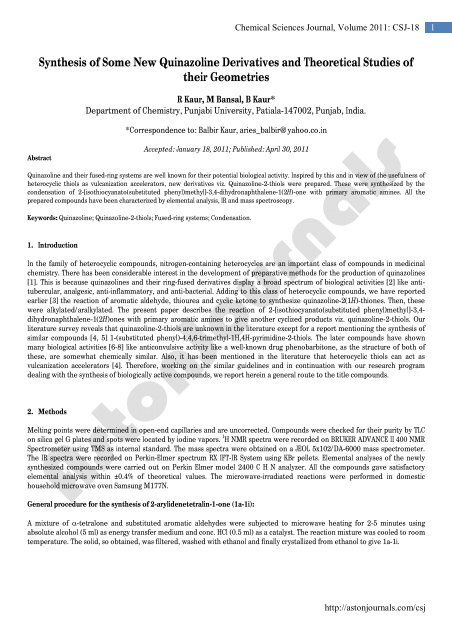
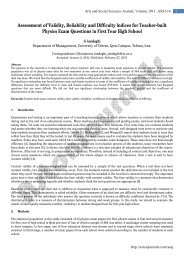
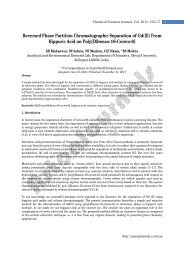
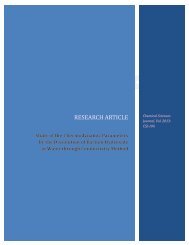
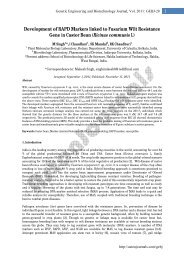

![[1,4]-benzodiazepine-2-one Derivatives as Potent - AstonJournals](https://img.yumpu.com/49117784/1/184x260/14-benzodiazepine-2-one-derivatives-as-potent-astonjournals.jpg?quality=85)
